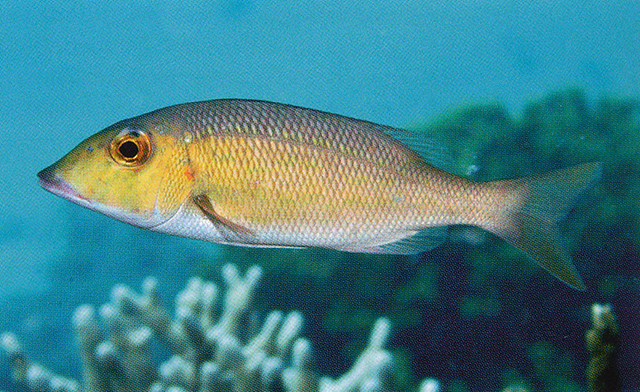| Lethrinidae (Emperors or scavengers), subfamily: Lethrininae |
| 70 cm TL (male/unsexed) |
|
reef-associated; marine; depth range 5 - 30 m, non-migratory |
| Pacific Ocean: Indonesia and the Philippines to the Marshall, Solomon and Marquesas islands, north to southern Japan, south to northwest Australia. Easily mistaken (particularly larger individuals) for either Lethrinus microdon or Lethrinus olivaceous. Common at Enewetak and Bikini Atolls (Ref. 37816). |
|
Dorsal spines (total): 10-10; Dorsal soft rays (total): 9-9; Anal spines: 3-3; Anal soft rays: 8-8. Description: Body is moderately elongate, its depth 3.1 to 3.4 times the SL. Color of body is yellowish with scattered indistinct dark blotches. The head is brown with light streaks; lips are reddish. The pectoral fin axil is orangish; the basal portion of the center rays is white, the outer edges is yellow. The pelvic and anal fins are white or yellowish. The dorsal and caudal fins are mottled brown or yellow with and orange or reddish edge (Ref. 2295). Distinct convex anterior snout profile but lacks distinctive markings (Ref. 37816). Moderately long snout, 1.7-1.9 in HL. Supratemporal patch 9-11 scales. (Ref. 90102) |
| Inhabits lagoons and deeper waters of coral reefs and adjacent sandy bottoms. Solitary in sand or rubble bottoms (Ref. 90102). Feeds mainly on fishes but also on mollusks, crustaceans, and sea urchins (Ref. 1602, 37816). Marketed fresh (Ref. 171). |
|
Least Concern (LC); Date assessed: 09 March 2015 Ref. (130435)
|
| harmless |
Source and more info: www.fishbase.org. For personal, classroom, and other internal use only. Not for publication.

